Input interpretation

O_2 oxygen + PbS lead sulfide ⟶ SO_2 sulfur dioxide + PbO_2 lead dioxide
Balanced equation
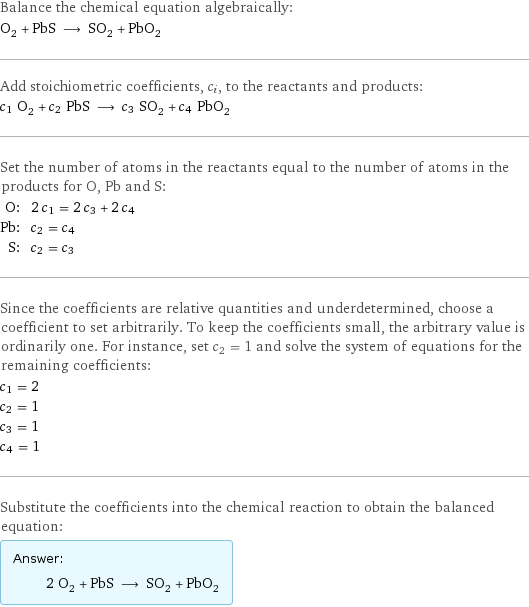
Balance the chemical equation algebraically: O_2 + PbS ⟶ SO_2 + PbO_2 Add stoichiometric coefficients, c_i, to the reactants and products: c_1 O_2 + c_2 PbS ⟶ c_3 SO_2 + c_4 PbO_2 Set the number of atoms in the reactants equal to the number of atoms in the products for O, Pb and S: O: | 2 c_1 = 2 c_3 + 2 c_4 Pb: | c_2 = c_4 S: | c_2 = c_3 Since the coefficients are relative quantities and underdetermined, choose a coefficient to set arbitrarily. To keep the coefficients small, the arbitrary value is ordinarily one. For instance, set c_2 = 1 and solve the system of equations for the remaining coefficients: c_1 = 2 c_2 = 1 c_3 = 1 c_4 = 1 Substitute the coefficients into the chemical reaction to obtain the balanced equation: Answer: | | 2 O_2 + PbS ⟶ SO_2 + PbO_2
Structures

+ ⟶ +
Names

oxygen + lead sulfide ⟶ sulfur dioxide + lead dioxide
Reaction thermodynamics
Enthalpy
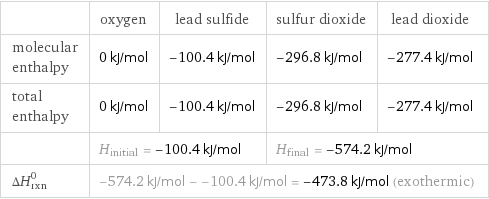
| oxygen | lead sulfide | sulfur dioxide | lead dioxide molecular enthalpy | 0 kJ/mol | -100.4 kJ/mol | -296.8 kJ/mol | -277.4 kJ/mol total enthalpy | 0 kJ/mol | -100.4 kJ/mol | -296.8 kJ/mol | -277.4 kJ/mol | H_initial = -100.4 kJ/mol | | H_final = -574.2 kJ/mol | ΔH_rxn^0 | -574.2 kJ/mol - -100.4 kJ/mol = -473.8 kJ/mol (exothermic) | | |
Gibbs free energy
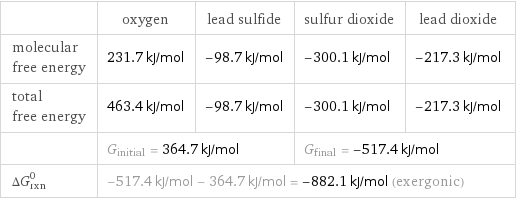
| oxygen | lead sulfide | sulfur dioxide | lead dioxide molecular free energy | 231.7 kJ/mol | -98.7 kJ/mol | -300.1 kJ/mol | -217.3 kJ/mol total free energy | 463.4 kJ/mol | -98.7 kJ/mol | -300.1 kJ/mol | -217.3 kJ/mol | G_initial = 364.7 kJ/mol | | G_final = -517.4 kJ/mol | ΔG_rxn^0 | -517.4 kJ/mol - 364.7 kJ/mol = -882.1 kJ/mol (exergonic) | | |
Entropy
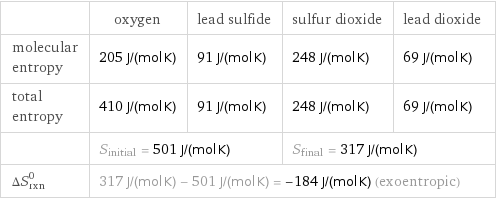
| oxygen | lead sulfide | sulfur dioxide | lead dioxide molecular entropy | 205 J/(mol K) | 91 J/(mol K) | 248 J/(mol K) | 69 J/(mol K) total entropy | 410 J/(mol K) | 91 J/(mol K) | 248 J/(mol K) | 69 J/(mol K) | S_initial = 501 J/(mol K) | | S_final = 317 J/(mol K) | ΔS_rxn^0 | 317 J/(mol K) - 501 J/(mol K) = -184 J/(mol K) (exoentropic) | | |
Equilibrium constant
![Construct the equilibrium constant, K, expression for: O_2 + PbS ⟶ SO_2 + PbO_2 Plan: • Balance the chemical equation. • Determine the stoichiometric numbers. • Assemble the activity expression for each chemical species. • Use the activity expressions to build the equilibrium constant expression. Write the balanced chemical equation: 2 O_2 + PbS ⟶ SO_2 + PbO_2 Assign stoichiometric numbers, ν_i, using the stoichiometric coefficients, c_i, from the balanced chemical equation in the following manner: ν_i = -c_i for reactants and ν_i = c_i for products: chemical species | c_i | ν_i O_2 | 2 | -2 PbS | 1 | -1 SO_2 | 1 | 1 PbO_2 | 1 | 1 Assemble the activity expressions accounting for the state of matter and ν_i: chemical species | c_i | ν_i | activity expression O_2 | 2 | -2 | ([O2])^(-2) PbS | 1 | -1 | ([PbS])^(-1) SO_2 | 1 | 1 | [SO2] PbO_2 | 1 | 1 | [PbO2] The equilibrium constant symbol in the concentration basis is: K_c Mulitply the activity expressions to arrive at the K_c expression: Answer: | | K_c = ([O2])^(-2) ([PbS])^(-1) [SO2] [PbO2] = ([SO2] [PbO2])/(([O2])^2 [PbS])](../image_source/b449967017274799033ab5985be0f577.png)
Construct the equilibrium constant, K, expression for: O_2 + PbS ⟶ SO_2 + PbO_2 Plan: • Balance the chemical equation. • Determine the stoichiometric numbers. • Assemble the activity expression for each chemical species. • Use the activity expressions to build the equilibrium constant expression. Write the balanced chemical equation: 2 O_2 + PbS ⟶ SO_2 + PbO_2 Assign stoichiometric numbers, ν_i, using the stoichiometric coefficients, c_i, from the balanced chemical equation in the following manner: ν_i = -c_i for reactants and ν_i = c_i for products: chemical species | c_i | ν_i O_2 | 2 | -2 PbS | 1 | -1 SO_2 | 1 | 1 PbO_2 | 1 | 1 Assemble the activity expressions accounting for the state of matter and ν_i: chemical species | c_i | ν_i | activity expression O_2 | 2 | -2 | ([O2])^(-2) PbS | 1 | -1 | ([PbS])^(-1) SO_2 | 1 | 1 | [SO2] PbO_2 | 1 | 1 | [PbO2] The equilibrium constant symbol in the concentration basis is: K_c Mulitply the activity expressions to arrive at the K_c expression: Answer: | | K_c = ([O2])^(-2) ([PbS])^(-1) [SO2] [PbO2] = ([SO2] [PbO2])/(([O2])^2 [PbS])
Rate of reaction
![Construct the rate of reaction expression for: O_2 + PbS ⟶ SO_2 + PbO_2 Plan: • Balance the chemical equation. • Determine the stoichiometric numbers. • Assemble the rate term for each chemical species. • Write the rate of reaction expression. Write the balanced chemical equation: 2 O_2 + PbS ⟶ SO_2 + PbO_2 Assign stoichiometric numbers, ν_i, using the stoichiometric coefficients, c_i, from the balanced chemical equation in the following manner: ν_i = -c_i for reactants and ν_i = c_i for products: chemical species | c_i | ν_i O_2 | 2 | -2 PbS | 1 | -1 SO_2 | 1 | 1 PbO_2 | 1 | 1 The rate term for each chemical species, B_i, is 1/ν_i(Δ[B_i])/(Δt) where [B_i] is the amount concentration and t is time: chemical species | c_i | ν_i | rate term O_2 | 2 | -2 | -1/2 (Δ[O2])/(Δt) PbS | 1 | -1 | -(Δ[PbS])/(Δt) SO_2 | 1 | 1 | (Δ[SO2])/(Δt) PbO_2 | 1 | 1 | (Δ[PbO2])/(Δt) (for infinitesimal rate of change, replace Δ with d) Set the rate terms equal to each other to arrive at the rate expression: Answer: | | rate = -1/2 (Δ[O2])/(Δt) = -(Δ[PbS])/(Δt) = (Δ[SO2])/(Δt) = (Δ[PbO2])/(Δt) (assuming constant volume and no accumulation of intermediates or side products)](../image_source/357ea0a9690351e45459612b81e24d66.png)
Construct the rate of reaction expression for: O_2 + PbS ⟶ SO_2 + PbO_2 Plan: • Balance the chemical equation. • Determine the stoichiometric numbers. • Assemble the rate term for each chemical species. • Write the rate of reaction expression. Write the balanced chemical equation: 2 O_2 + PbS ⟶ SO_2 + PbO_2 Assign stoichiometric numbers, ν_i, using the stoichiometric coefficients, c_i, from the balanced chemical equation in the following manner: ν_i = -c_i for reactants and ν_i = c_i for products: chemical species | c_i | ν_i O_2 | 2 | -2 PbS | 1 | -1 SO_2 | 1 | 1 PbO_2 | 1 | 1 The rate term for each chemical species, B_i, is 1/ν_i(Δ[B_i])/(Δt) where [B_i] is the amount concentration and t is time: chemical species | c_i | ν_i | rate term O_2 | 2 | -2 | -1/2 (Δ[O2])/(Δt) PbS | 1 | -1 | -(Δ[PbS])/(Δt) SO_2 | 1 | 1 | (Δ[SO2])/(Δt) PbO_2 | 1 | 1 | (Δ[PbO2])/(Δt) (for infinitesimal rate of change, replace Δ with d) Set the rate terms equal to each other to arrive at the rate expression: Answer: | | rate = -1/2 (Δ[O2])/(Δt) = -(Δ[PbS])/(Δt) = (Δ[SO2])/(Δt) = (Δ[PbO2])/(Δt) (assuming constant volume and no accumulation of intermediates or side products)
Chemical names and formulas
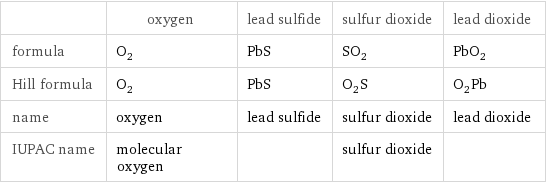
| oxygen | lead sulfide | sulfur dioxide | lead dioxide formula | O_2 | PbS | SO_2 | PbO_2 Hill formula | O_2 | PbS | O_2S | O_2Pb name | oxygen | lead sulfide | sulfur dioxide | lead dioxide IUPAC name | molecular oxygen | | sulfur dioxide |
Substance properties
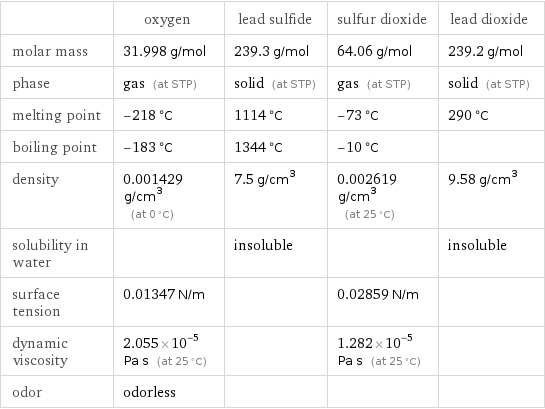
| oxygen | lead sulfide | sulfur dioxide | lead dioxide molar mass | 31.998 g/mol | 239.3 g/mol | 64.06 g/mol | 239.2 g/mol phase | gas (at STP) | solid (at STP) | gas (at STP) | solid (at STP) melting point | -218 °C | 1114 °C | -73 °C | 290 °C boiling point | -183 °C | 1344 °C | -10 °C | density | 0.001429 g/cm^3 (at 0 °C) | 7.5 g/cm^3 | 0.002619 g/cm^3 (at 25 °C) | 9.58 g/cm^3 solubility in water | | insoluble | | insoluble surface tension | 0.01347 N/m | | 0.02859 N/m | dynamic viscosity | 2.055×10^-5 Pa s (at 25 °C) | | 1.282×10^-5 Pa s (at 25 °C) | odor | odorless | | |
Units
